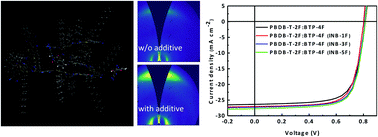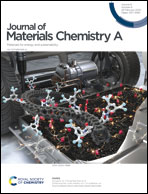Fluorinated solid additives enable high efficiency non-fullerene organic solar cells†
Abstract
The use of processing additives to optimize the active layer morphology in organic solar cells (OSCs) is a simple and impactful way to improve photovoltaic performance. However, the retention of high boiling point liquid additives affects the stability and lifetime of OSCs, necessitating the development of volatilizable additives that can improve efficiency at no cost of the long-term device stability. In this study, three novel volatilizable solid additives, INB-1F, INB-3F, and INB-5F, with different degrees of fluorination, are rationally designed, synthesized and added into photovoltaic solutions to fabricate OSCs. These additives evaporate upon moderate thermal annealing and exhibit higher volatility as the number of fluorine atoms increases. Our device studies show that these additives can enhance the efficiency of PBDB-T-2F:BTP-4F binary cells from 15.2% to 16.5%, and that of PBDB-T-2F:IT-4F from 12.1% to 13.4%. Molecular dynamics simulations reveal attractive interactions between these additives and the non-fullerene acceptor BTP-4F, leading to enhanced intermolecular π–π stacking among BTP-4Fs, which is a favorable morphological change that we attribute to the origin of the enhanced performance and long-term stability. Our work presents a novel strategy to design new solid additives to replace liquid additives toward efficient and stable OSCs.



 Please wait while we load your content...
Please wait while we load your content...